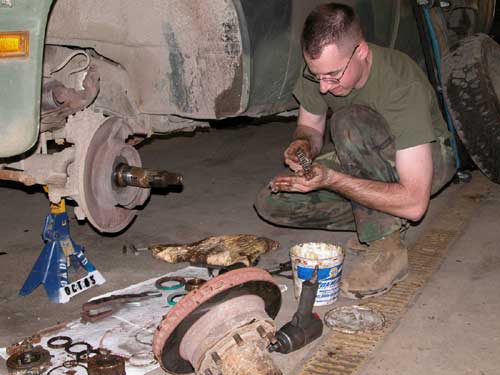 By Maj. Richard Sater, U.S. Air Force Reserve June 13, 2005
The Hemlock Bay maintenance crew ensures that the vehicles - from pickup trucks to five-tons and ambulances - are road-ready and running, and that keeps Operation Alaskan Road running too. It's a big job, a big responsibility, a dirty-cool job.  Photo by Maj. Richard Sater, U.S. Air Force Reserve, Joint Task Force Alaskan Road
Approximately 12 miles of road are under construction in various phases, with military teams clearing the land and then drilling, blasting, filling, compacting, and installing culverts in preparation for final surfacing, which will be handled by the Federal Highway Administration. Vehicle maintenance, by necessity, becomes a high priority, see? The maintenance shop might be a bit understaffed, which doesn't hamper the enthusiasm of the 30-plus mechanics who report for duty every morning. A 45-minute bumpy ride down the old logging road delivers them to the facility, located on the edge of Hemlock Bay. Yeah, it's as beautiful a locale for a garage as you'll ever find, but this is no place for tourists.
It's a joint-service team, and they work together as teams of two or three or four or more depending on the job to be done. Got a broken axle to replace in an ambulance? Might take five, six guys to wrestle it in place and bolt it down. Checking air pressure in tires or changing oil? Maybe one guy. Depends. There's a lot of healthy discussion about the best way, a lot of consulting of technical orders, a lot of experience - civilian and military - that makes this place tick. A lot of healthy competition too. It's the life of trade. The environment here is tough as it can be for a vehicle - rough terrain and extremes in weather conspire against 'em. These are sullen trucks, angry old men that don't listen and don't like you. "These trucks are older than me," mutters one sergeant who's got enough years to know. Parts, at least, are plentiful, obtained via local purchase or military supply channels. Tools too are well-stocked, and the still-sort-of-new facility (corrugated quonset-hut style) has garage doors on either end. Closed, the shop holds in heat and keeps out rain; open, it lets in sun. Coveralls cover all in this theme park of diesel and dirt and grease. You smell it in the air, hear it in the clang of wrench against engine block, even in the uneasy mix of rap and country blasting from the stereo, but it's good, clean dirt, the kind that gives you satisfaction to roll up your sleeves to. "I think of it as an art," says Lance Cpl. Jake Schambach, Detachment 3, Motor Transport Maintenance Company, 4th Maintenance Battalion (U.S. Marine Corps Reserve), Sacramento, Calif. Nothing beats the electric charge of "watching something towed in, being driven out," says Lance Cpl. Tim Hendrickson, 4th Combat Engineer Battalion, 4th Marine Division (U.S. Marine Corps Reserve), Baltimore, Md. Nothing is unfixable, he says, confident. But here's the secret code: "Keep your patience," he says. "You get frustrated, and it's 10 times worse." Good advice, because there's room for as much frustration as you can cram into your pack. "There's a whole line of trucks to be worked on," points out Lance Cpl. Arthur Hayden, also with the 4th MTMC. "Always something that needs fixing." "And," says Lance
Cpl. Bogumil Bazyluk, also 4th CEB, "it's nothing that can't
be done." It's the quality repair, not quantity, that will
judge the success of the maintenance crew.  Photo by Maj. Richard Sater, U.S. Air Force Reserve, Joint Task Force Alaskan Road
Maybe the big picture is hard to see from the garage floor with oil dripping on your coveralls, but it's there, underneath, and "it's huge," says maintenance commander 1st Lt. Richard Uggen, 139th Field Artillery Regiment (U.S. Army National Guard), Lafayette, Ind. He estimates the crew is responsible for at least 150 different vehicles. The view from the maintenance facility: "If things don't happen here, things don't happen on the road," Uggen says. "Mission-planning depends on equipment and allocation of resources." About a third of his mechanics are here for the duration, with the rest rotating through in two-week cycles, the Reserve/Guard annual tour requirement. Pairing the experienced with the less-so (and the second-time-arounders with the first-time-in-Alaska guys) makes solid sense. Any six vehicles are being worked on at one time, maybe more. Simple things like routine and preventive maintenance are quick; some jobs take hours. Others, days. The procession never ends. Good. Job security. This is the way the Joint Task Force makes an Alaskan road. Cpl. Dustin Ferguson, also with the Sacramento unit, and Pvt. 1st Class Adam Cira, 98th Maintenance Company (U.S. Army), Fort Richardson, Alaska, remove an axle assembly from another truck (a command-approved substitution) in the parking lot to fix a necessary ambulance. A quarter-turn at a time, the rusty bolts surrender to the simple machine, leverage, and just a little superhuman effort. Lodged underneath the jacked-up truck, Ferguson pauses, sighs deep, grins. "Could be raining," he says. That kind of bright-side-looking wins wars. And builds roads. Be safe. Drink water. Get to
work.
is the Joint Task Force Alaskan Road Public Affairs Officer. Publish A Letter on SitNews Read Letters/Opinions Submit A Letter to the Editor
|
||
